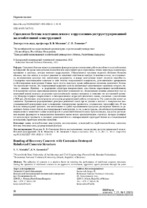| dc.contributor.author | Молодин, В. В. | |
| dc.contributor.author | Леонович, С. Н. | |
| dc.coverage.spatial | Минск | ru |
| dc.date.accessioned | 2022-02-22T13:12:54Z | |
| dc.date.available | 2022-02-22T13:12:54Z | |
| dc.date.issued | 2022 | |
| dc.identifier.citation | Молодин, В. В. Сцепление бетона восстановления с коррозионно-деструктурированной железобетонной конструкцией = Bonding of Recovery Concrete with Corrosion-Destroyed Reinforced Concrete Structure / В. В. Молодин, С. Н. Леонович // Наука и техника. – 2022. – № 1. – С. 36-41. | ru |
| dc.identifier.uri | https://rep.bntu.by/handle/data/109817 | |
| dc.description.abstract | Сцепление бетонов является решающим фактором при восстановлении работоспособности железобетонных конструкций. Во время эксплуатации железобетона в агрессивной среде агрессивные агенты через поры и капилляры проникают к арматуре, которая начинает корродировать. Образующиеся продукты коррозии обладают большим объемом, чем сам металл, и создают давление на защитный слой бетона изнутри. В конечном счете, он отслаивается, незащищенная арматура еще интенсивнее разрушается, и вскоре конструкция теряет несущую способность. Стандартное восстановление включает в себя очистку поврежденной поверхности, дополнительное армирование и обетонирование конструкции. Однако часто спустя некоторое время наблюдается отслоение ремонтного бетона. Это происходит потому, что поврежденный коррозией слой не обеспечивает качественного сцепления «старого» бетона с «новым». Причина – в разрушении структуры поверхностного слоя бетона агрессивными воздействиями. В большинстве случаев агрессивным агентом выступает углекислый газ. Исследование влияния углекислого газа на цементный камень показало разрушение кристаллического каркаса материала и снижение его когезионной прочности. Микрофотографии поврежденного и неповрежденного коррозией цементного камня, сделанные с увеличением в 7000 раз, убедительно демонстрируют результаты разрушительной работы углекислоты. Это существенно влияет на сцепление. Применение форсированного разогрева ремонтной смеси при ее укладке в контакт с поверхностью восстанавливаемой конструкции ведет к появлению температурных градиентов, усиливающих термодиффузию. И чем больше температурный градиент, тем интенсивнее и глубже проникновение продуктов растворения цемента из ремонтного бетона в тело бетона восстанавливаемой конструкции. А это, в свою очередь, способствует пропитыванию поврежденного цементного камня жидкой фазой из ремонтной бетонной смеси. Кристаллизуясь, продукты растворения цемента формируют в поврежденном цементном камне новую кристаллическую структуру, которая усиливает его когезионную прочность и связывает ремонтный бетон с неповрежденной структурой бетона восстанавливаемой конструкции, гарантируя качество сцепления. | ru |
| dc.language.iso | ru | ru |
| dc.publisher | БНТУ | ru |
| dc.title | Сцепление бетона восстановления с коррозионно-деструктурированной железобетонной конструкцией | ru |
| dc.title.alternative | Bonding of Recovery Concrete with Corrosion-Destroyed Reinforced Concrete Structure | ru |
| dc.type | Article | ru |
| dc.identifier.doi | 10.21122/2227-1031-2022-21-1-36-41 | |
| local.description.annotation | The adhesion of concrete is a decisive factor in restoring the performance of reinforced concrete structures. During the operation of reinforced concrete in an aggressive environment, aggressive agents penetrate through the pores and capillaries to the reinforcement which begins to corrode. The resulting corrosion products have a large volume than the metal itself, and create pressure on the protective layer concrete from the inside. Ultimately, it exfoliates, the unprotected reinforcement is destroyed even more intensively, and soon the structure loses its bearing capacity. Standard restoration includes cleaning the damaged surface, additional reinforcement and concrete coating of the structure. However, after sometime, peeling of the repair concrete is often observed. This is because a layer damaged by corrosion does not provide high-quality adhesion of the “old” concrete to the “new” one. The reason is the destruction of the structure of the surface concrete layer by aggressive influences. In most cases, carbon dioxide is an aggressive agent. The study of the effect of carbon dioxide on cement stone has shown the destruction of the crystalline framework of the material and a decrease in its cohesive strength. Micrographs of cement stone damaged and undamaged by corrosion, taken with magnification 7000 times, convincingly demonstrate the results of the destructive work of carbon dioxide. This has a significant effect on grip. The use of forced heating of the repair mixture when it is placed in contact with the restored structure leads to the appearance of temperature gradients that enhance thermal diffusion. And the greater the temperature gradient, the more intense and deeper the penetration of the cement dissolution products from the repair concrete into the concrete body of the structure being restored. And this, in turn, contributes to the impregnation of the damaged cement stone with the liquid phase from the repair concrete mixture. Crystallizing, the cement dissolution products form a new crystalline structure in the damaged cement stone, which enhances its cohesive strength and binds the repair concrete to the intact concrete structure of the restored structure, ensuring the quality of adhesion. | ru |

